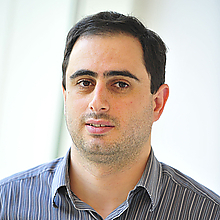 Mohammad T. Hajiaghayi, the Jack and Rita G. Minker Associate Professor of Computer Science with an appointment in UMIACS, was recently awarded a $500,000 National Science Foundation (NSF) grant to make big data more accessible on personal devices like smartphones and tablets.
Mohammad T. Hajiaghayi, the Jack and Rita G. Minker Associate Professor of Computer Science with an appointment in UMIACS, was recently awarded a $500,000 National Science Foundation (NSF) grant to make big data more accessible on personal devices like smartphones and tablets.
The award—part of the NSF’s Division of Information and Intelligent Systems BIGDATA program—will support Hajiaghayi’s ongoing work to develop algorithms that enable the processing of huge datasets on computational devices with a limited amount of fast memory, or that are connected to a relatively slow external data source.
“This research is especially important for potential users who may not have access to supercomputers to manipulate such big data,’’ he says.
Big networks are constantly growing in both size and relevance: from social networks such as Facebook and Twitter, gene regulatory networks, health/disease networks, and more. The traditional approach to analyzing such big datasets is to use powerful supercomputers—clusters—ideally large enough to store the data in main memory.
However, the downsides to this approach are that many potential users of big data lack such powerful computational resources, making it difficult to solve unexpected problems within such a large infrastructure.
For example, Hajiaghayi says, information analysis for the Boston Marathon bombing in April 2013 was difficult because ad-hoc search over heterogeneous data from multiple sources such as store cameras, social media, social networks, etc. was not indexed for this use and purpose as needed.
Hajiaghayi notes the NSF-funded project will investigate the extent to which complex network analysis can be performed on a single computer—or even a mobile device such as a smartphone.
To this end, the project will develop external-memory, cache-oblivious, and streaming algorithms for analyzing and understanding big network data—even on relatively weak computational devices. These algorithms will make big data analysis accessible to a much broader audience, he says, which will enable new applications.
Hajiaghayi’s approach uniquely combines advanced algorithmic techniques, including approximation algorithms, parameterized algorithms, graph algorithms, graph structure theory, and computational geometry to solve real-world problems on big networks.